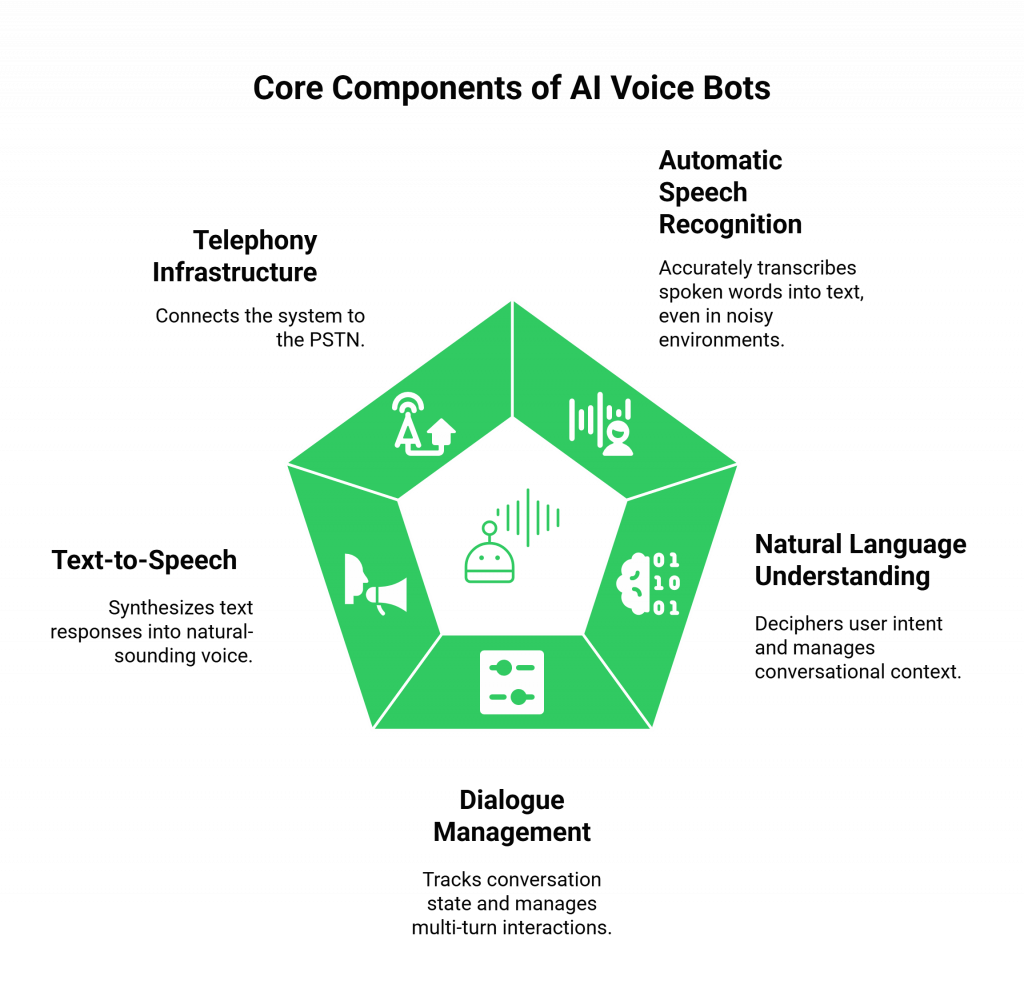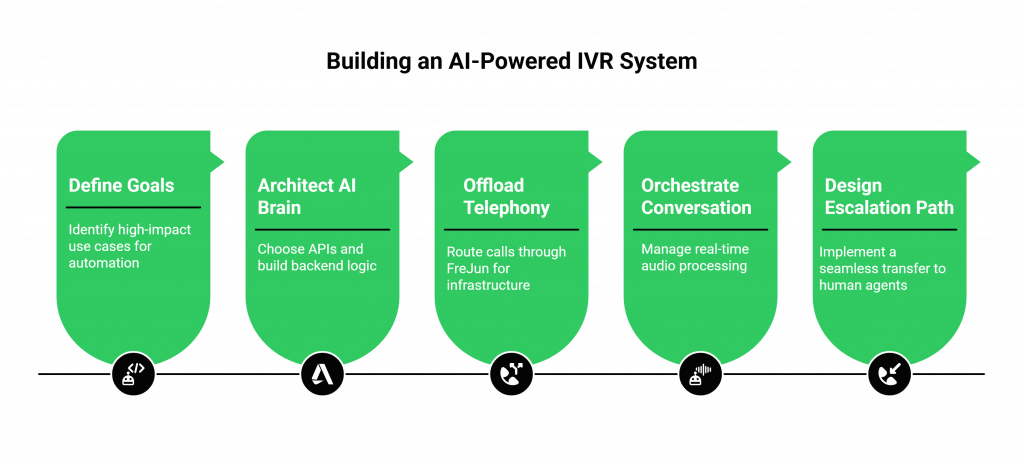The traditional IVR (Interactive Voice Response) system is a relic of a bygone era. For decades, it has been a source of customer frustration, forcing callers through a rigid, confusing maze of “press one for sales, press two for support” menus. The modern enterprise is tearing down this outdated structure and replacing it with a far more intelligent and intuitive solution: the Voice Bot for AI-Powered IVRs. This new breed of IVR doesn’t just route calls; it resolves them. It listens, understands, and engages in natural, human-like conversations to provide a faster, more satisfying customer experience.
Table of contents
- What is the “Best” Voice Bot for AI-Powered IVRs?
- The Hidden Hurdle: Why Your Brilliant Bot Can’t Talk on the Phone
- FreJun: The Infrastructure Layer That Powers Your IVR’s Brain
- The Traditional IVR vs. The Modern AI-Powered IVR: A Comparison
- A Step-by-Step Guide to Building the Best Voice Bot for Your IVR
- Best Practices for a Flawless, High-Containment IVR
- Final Thoughts: From a Clunky Menu to a Smart Conversation
- Frequently Asked Questions (FAQ)
Building the “brain” for this system, the AI that can understand complex queries, manage multi-turn dialogues, and integrate with backend systems, has never been more accessible. However, the biggest challenge is not the AI itself. The real hurdle is connecting this intelligent brain to the complex, archaic world of telephony in a way that is reliable, scalable, and doesn’t compromise the real-time performance that a natural conversation demands.
What is the “Best” Voice Bot for AI-Powered IVRs?

The best Voice Bot for AI-Powered IVRs is not a single product but a seamlessly integrated system of best-in-class components. It’s an architecture designed to replace the rigidity of touch-tone menus with the flexibility of natural language conversation. The core components include:
- Automatic Speech Recognition (ASR): The “ears” of the system, which accurately transcribe a caller’s spoken words into text, even in noisy environments.
- Natural Language Understanding (NLU/LLM): The “brain.” A powerful language model, like GPT-4o, that deciphers the user’s intent, extracts key information, and manages the conversational context.
- Dialogue Management: The “nervous system.” This is the logic that tracks the state of the conversation, manages multi-turn interactions, and decides when to query backend systems or escalate to a human agent.
- Text-to-Speech (TTS): The “mouth,” which synthesizes the AI’s text response back into a clear, natural-sounding voice.
- Telephony Infrastructure: The underlying foundation that connects the entire system to the Public Switched Telephone Network (PSTN).
When these components work together flawlessly, the result is an IVR that doesn’t feel like a machine, but like a competent and helpful assistant.
The Hidden Hurdle: Why Your Brilliant Bot Can’t Talk on the Phone
You have created a brilliant AI “brain.” You’ve chosen the best ASR, LLM, and TTS engines, and you’ve written the orchestration logic to make them work together. Your bot is a conversational genius in your development environment. Now, you need to deploy it on your company’s main phone line. This is where most projects hit a wall.
The entire ecosystem of AI APIs is designed to process data, not to manage live phone calls. To connect your bot’s brain to the PSTN, you would have to build a highly specialized and complex voice infrastructure stack from the ground up. This involves solving a host of daunting engineering problems:
- Managing SIP Trunks and Carrier Relationships: The complex, low-level work of connecting to the global phone network.
- Building and Maintaining Real-Time Media Servers: The specialized hardware and software needed to handle raw audio streams from thousands of concurrent calls.
- Ensuring High Availability and Geo-Redundancy: The enterprise-grade requirement to keep your phone lines open 24/7, even in the event of a data center outage.
This is the hidden hurdle. Your team, expert in AI and conversation design, is suddenly forced to become telecom engineers, a massive diversion of resources that kills momentum and introduces significant project risk.
FreJun: The Infrastructure Layer That Powers Your IVR’s Brain
This is the exact problem FreJun was built to solve. We are not another AI platform. We are the specialized voice infrastructure layer that provides the enterprise-grade foundation for your custom-built Voice Bot for AI-Powered IVRs.
FreJun handles the entire complex, messy, and mission-critical telephony half of the equation, allowing your team to focus exclusively on building the best AI “brain” possible.
- We are AI-Agnostic: You bring your own bot. FreJun integrates seamlessly with any backend built on any combination of ASR, LLM, and TTS APIs.
- We Guarantee Enterprise-Grade Reliability: Our platform is built on a resilient, geographically distributed infrastructure that is designed to handle massive call volumes with guaranteed uptime.
- We Provide a Simple, Developer-First API: Our API abstracts away all the complexities of telephony, providing a clean, secure, and scalable connection point for your application.
With FreJun, you can finally connect your brilliant AI to the real world, without having to build a telecom company to do it.
The Traditional IVR vs. The Modern AI-Powered IVR: A Comparison
| Feature | Traditional IVR | The Modern Voice Bot for AI-Powered IVRs (with FreJun) |
| Input Method | DTMF/touch-tone | Natural language speech |
| Conversation Flow | Rigid, menu-driven | Flexible, multi-turn, and contextual |
| Personalization | Static, generic scripts | Dynamic, personalized with real-time CRM data |
| Self-Learning | Requires manual updates | Continuously improves with every conversation |
| Customer Experience | Often frustrating | Intuitive, efficient, and conversational |
| Infrastructure | On-premise hardware | A custom AI brain powered by a cloud infrastructure API |
A Step-by-Step Guide to Building the Best Voice Bot for Your IVR
This guide outlines the modern, scalable process for creating a next-generation AI-powered IVR.

Step 1: Define Your Goals and Start Small
Begin by identifying the highest-impact use cases for automation. Don’t try to boil the ocean. A great strategy is to start by overlaying conversational AI on top of your existing IVR to handle the top 3-5 most common call reasons.
Step 2: Architect Your AI “Brain”
Choose your preferred ASR, LLM, and TTS APIs. Build your backend orchestration logic in a framework like FastAPI or Node.js. This is where you will design your dialogue flows and integrate with your business systems (like your CRM or booking database).
Step 3: Offload All Telephony to FreJun
This is the most critical architectural decision. Instead of building your own voice infrastructure, you route your inbound calls through FreJun.
- Sign up for FreJun and instantly provision a virtual phone number.
- Use FreJun’s server-side SDK in your backend to handle incoming WebSocket connections from our platform.
- In the FreJun dashboard, configure your number’s webhook to point to your backend’s API endpoint.
Step 4: Orchestrate the Real-Time Conversation
When a customer calls your FreJun number, the end-to-end flow is simple and elegant:
- FreJun streams the live audio to your backend.
- Your backend orchestrates the AI pipeline: ASR -> NLU/LLM -> Dialogue Management -> TTS.
- Your backend streams the synthesized audio response back to FreJun, which plays it to the caller.
Step 5: Design a Seamless Escalation Path
No bot can handle 100% of queries. The “best” Voice Bot for AI-Powered IVRs knows when to get a human involved. Program your dialogue manager to recognize when an escalation is needed. Your backend can then make a simple API call to FreJun to transfer the live call, along with the full conversation context, to the appropriate human agent queue.
Best Practices for a Flawless, High-Containment IVR
- Prioritize ASR and NLU Accuracy: The success of your IVR hinges on its ability to understand the caller. Invest in high-quality speech and language models and continuously train them on your specific domain and user data.
- Ensure Deep Backend Integration: A truly helpful bot can do more than just talk; it can take action. Deeply integrate your bot with your CRM and other systems to allow it to perform tasks like checking an order status or updating an account.
- Continuously Monitor KPIs: Track your key metrics relentlessly. Are your containment rates improving? Is customer satisfaction going up? Use this data to make data-driven decisions about how to improve your bot’s performance.
- Design for a Graceful Failure: When the bot doesn’t understand, it shouldn’t just repeat “I’m sorry, I didn’t get that.” Design clear, empathetic fallback paths that guide the user or offer to connect them to a human.
Final Thoughts: From a Clunky Menu to a Smart Conversation
The era of the frustrating, menu-driven IVR is over. The technology now exists to create a customer experience that is not only efficient but genuinely pleasant. The key to building the best Voice Bot for AI-Powered IVRs is a smart, strategic approach to the architecture.
By separating the “brain” from the “body,” you can focus your valuable engineering resources on what you do best: building a brilliant, conversational AI. Let a specialized, enterprise-grade platform like FreJun handle the complex, undifferentiated heavy lifting of the telephony infrastructure. This is the modern blueprint for success, a future where every call is an opportunity to have a smart, satisfying conversation.
Further Reading – Real-Time Conversational AI Voice Integration Using APIs
Frequently Asked Questions (FAQ)
No, it integrates with them. You use those platforms to build the “brain” of your IVR. FreJun provides the separate, essential voice infrastructure “body” that connects that brain to the telephone network at an enterprise scale.
Yes. A great way to start is to forward a specific option from your existing IVR (e.g., “Press 5 for an automated status update”) to your FreJun number. This allows you to incrementally add AI capabilities without replacing your entire system at once.
Your bot’s backend logic would determine when a handoff is needed. It would then make a simple API call to FreJun to transfer the live call to the appropriate human agent queue in your contact center. The full conversation context can be passed to the agent’s CRM simultaneously via a separate API call.
This architecture is highly scalable. FreJun’s infrastructure is built to handle massive call concurrency. By designing your backend to be stateless, you can use standard cloud auto-scaling to handle any amount of traffic, ensuring your service is both resilient and cost-effective.
The “best” bot is one that delivers on its business objectives. This typically means a high containment rate (resolving issues without needing a human), high customer satisfaction scores, and seamless, low-latency performance. Achieving this requires both a smart AI “brain” and a robust, reliable voice infrastructure.
